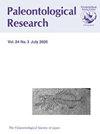特刊《古生代演化研究的复兴:辐射与灭绝》:前言
IF 0.6
4区 地球科学
Q3 PALEONTOLOGY
引用次数: 0
摘要
大约5.4亿年前,前寒武纪世界结束后,通过快速的生物多样性,我们的星球上首次出现了具有多样生物群的熟悉景观。从那时起,显生宙的前300 Myr,即古生代,见证了全球环境的不可逆转的变化,伴随着陆地和海洋生态空间的扩张和多样化。古生代这种单向进化史的原因和过程通常被归因于多个间断的事件,每一个事件都引发了全球范围的环境变化,以限制进化的方向。例如,寒武纪大爆发、奥陶纪生物多样性大事件(GOBE)以及分别发生在奥陶纪、泥盆纪和二叠纪末的三次大灭绝,都是这些不同寻常的变化的吸引人的陈词滥调/概念,这些变化不仅在专业科学家中,而且在记者中都非常流行。一些标志性的贡献点燃了人们对地球历史的兴趣;即寒武纪大爆发(Gould,1989)、白垩纪末期的玻利维亚撞击故事(Alvarez et al.,1980)、清晰图表中长期生物多样性模式的可视化(Raup和Sepkoski,1982)以及雪球地球假说(Kirschvink,1992;Hoffman和Schrag,1998)。对古生代这些“大事件”的可能原因/驱动因素的研究仍在继续,发表了大量科学文章。除了地外撞击外,20世纪90年代还提出了海洋氧化还原变化和间歇性超级火山活动等可能的关键机制;尽管如此,在本世纪,人们的兴趣开始下降。目前剩下的是由相同的分析技术产生的大量类似数据,特别是使用各种地球化学/同位素替代物,以及从几乎相同的角度进行的许多类似讨论。这可能反映了科学界目前过于强调评估研究的定量指标,如引用次数和期刊影响因素(Garfield,特刊“古生代进化研究的复兴:辐射与灭绝”:序言本文章由计算机程序翻译,如有差异,请以英文原文为准。
Special Issue “Renaissance for Paleozoic Evolution Studies: Radiation and Extinction”: Preface
Familiar landscapes with diverse biota first appeared on our planet through rapid biodiversification immediately after the termination of the Precambrian world, about 540 Myr ago. Since then the first 300 Myr of the Phanerozoic, i.e., the Paleozoic Era, witnessed irreversible changes in global environment in association with the expansion and diversification of eco-spaces, both on land and in the oceans. The causes and processes of this unidirectional evolutionary history during the Paleozoic have often been attributed to multiple punctuated episodes, each of which triggered global-scale environmental changes to constrain the direction of evolution. For example, the Cambrian explosion, the Great Ordovician Biodiversification Event (GOBE), and three major mass extinctions, at the end of the Ordovician, Devonian, and Permian, respectively, are attractive clichés/concepts for these unusual changes that have become extremely popular, not only among professional scientists, but also with journalists. Such elevated interest in Earth history was ignited by some iconic contributions; i.e., the Cambrian Explosion (Gould, 1989), the bolide impact story for the end-Cretaceous timing (Alvarez et al., 1980), the visualization of long-term biodiversity patterns in a clear diagram (Raup and Sepkoski, 1982), and the snowball Earth hypothesis (Kirschvink, 1992; Hoffman and Schrag, 1998). The search for possible causes/drivers of these “big events” of the Paleozoic has continued, yielding numerous scientific articles. In addition to extraterrestrial impact, several stimulating ideas such as ocean redox change and intermittent supervolcanism were proposed as possible key mechanisms during the 1990s; nonetheless, interest started to decline in this century. What remains at present is a huge pile of similar data produced by the same analytical techniques, particularly with various geochemical/isotopic proxies, and many similar discussions from almost the same viewpoints. This may reflect the current overemphasis on quantitative measures for evaluating research, such as the number of citations and journal impact factors, in the scientific community (Garfield, Special Issue “Renaissance for Paleozoic evolution studies: radiation and extinction”: Preface
求助全文
通过发布文献求助,成功后即可免费获取论文全文。
去求助
来源期刊

Paleontological Research
PALEONTOLOGY-
CiteScore
1.60
自引率
0.00%
发文量
47
审稿时长
>12 weeks
期刊介绍:
Paleonotological Research (PR) is a quarterly, peer-reviewed international journal, which focuses on original contributions primarily in the area of paleontology but also covering a wide range of allied sciences. It has been published since 1997 as a successor to the former journal Transactions and Proceedings of the Palaeontological Society of Japan. The emphasis of contributions will include global and local perspectives, and contents can cover all ages (Precambrian to the Quaternary, including the present time).
 求助内容:
求助内容: 应助结果提醒方式:
应助结果提醒方式:


